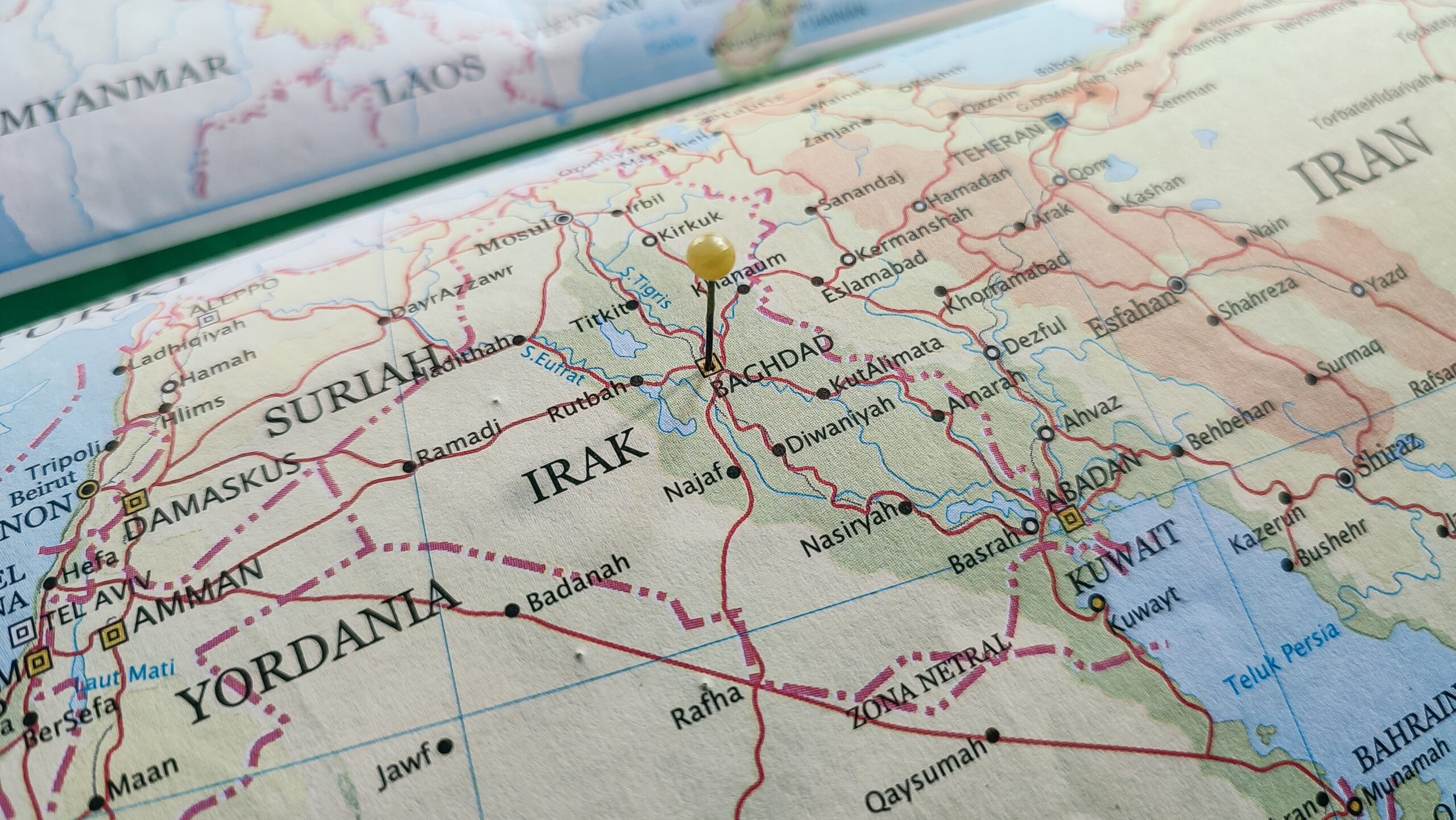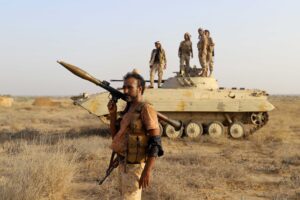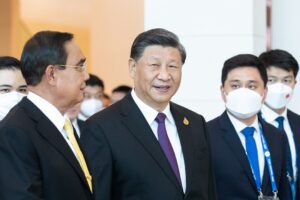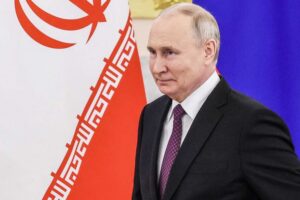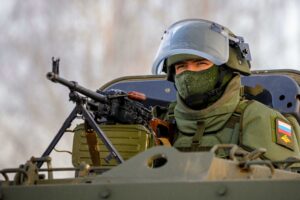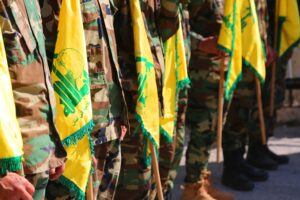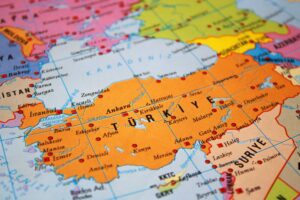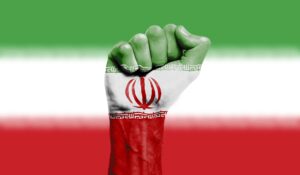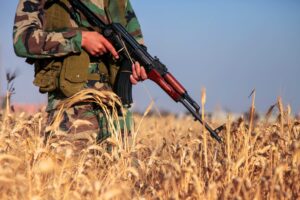*The article was originally written in French and translated into English by Naman Karl-Thomas Habtom and Ségolène Gence.
From the fall of Baghdad in 2003 till the fall of the Caliphate in 2017, from Arab nationalism dreaming of a unified Arab state from Morocco to Iraq to a system forged in the Sunni-ness[1] hoping for a state-like entity on part of Iraqi territory, the course of the Sunni community—since the American occupation of the country to the present day—takes form within a set of paradoxes, strategic shifts, and situational transformations in the perception of the enemy. This is what we are going to highlight in this chapter.
The Fall
The fall of Baghdad on 9 April 2003 is a fundamental moment in the political history of the Sunni community in Iraq because it put an end to 365 years of Sunni political domination in Iraq, the country of the two rivers. The occupation of Baghdad by the Americans in 2003 at the arrival of Paul Bremer in the country are often compared by Sunni elites to the Persian occupation of Baghdad in 1623 and the arrival of Shah Abbas in the city of Haroun ar-Rashid.[2] Known for his extreme violence, Shah Abbas organised a large scale genocide of Sunnis and carried out a total confessional cleansing of Baghdad[3] but, thanks to the intervention of the Ottomans fifteen years later, in 1638, the survivors of the genocide returned and took political power until 2003, with the British occupation of the country in 1917 only serving to reinforce Sunni power in Iraq.
Certainly, Paul Bremer did not personally organise the genocide of the Sunnis but in fact he prepared the objective conditions in which the Shia militias, allies of the United States in 2003, coordinated the systematic “de-sunnification”[4] of the country. Upon his arrival in Baghdad in May 2003, the two decrees on the de-baathification[5] of the state and the dissolution of the army were signed and implemented.
As a consequence of their application, several hundreds of thousands of Sunnis, often well-trained managers, found themselves unemployed, without income, and left to their own devices. In addition, Bremer subsequently handed the running of the country primarily to the Shiites and marginally to the Kurds, those who were until then excluded and who now only accept a symbolic Sunni representation within the Iraqi state.
Those two factors actively contributed to the development and the consolidation of the feeling among the Sunnis that they were not welcomed in the new American Iraq, as if they were responsible for the attacks of the 11th of September 2001 and as though they now had to pay for a crime they did not commit. The Islamic Party, the Iraq branch of the Muslim Brotherhood and the historical rival of the Ba’ath Party with whom it competed for the Sunni social base, tried in vain to present itself as the spokesperson of the Sunnis in the new Iraq.[6] In fact, the latter chose to categorically reject the political system of the new Iraq and chose to engage in a resistance that adopted terrorist violence as a weapon of war.
So, officers of the old military, agents of the old intelligence service, the leaders of the Ba’ath Party, dismissed civil servants, some religious believers driven by the vocation of holy war, young people without any future prospects, tribes without any access to financial resources of the state engaged, alongside internationalist jihadis who had recently arrived in Iraq in ultra-violent actions against both the American occupation and against the Iraqi actors integrated into the political system of the new Iraq. So, in a few months, the provinces that constitute the Sunni country transformed themselves into a veritable warzone with the victims numbering by the thousands on all sides. In 2003 there were 12,133 deaths, 11,737 in 2004, 16,583 in 2005, and 29,526 in 2006.[7]

Car bombings, surprise attacks, hostage takings, suicide operations… the Sunni resistance[8] hit the reconstruction project of the new Iraq hard according to Paul Bremer, but it remains at an impasse, without any possible exit, notably since the jihadi Salafists took control of it and decided on its orientations.
The Stalemate
Initially, the resistance did not present itself as a homogeneous movement, coordinated by a unified leadership around an action strategy designed for a commonly shared objective. On the contrary, the resistance is composed of a sociologically significant heterogeneity.
First of all, the traditionalist ulamas (Islamic scholars) regroupes around Harith al-Dhari (1941-2015), the head of the group of Muslim ulamas. An emblematic figure, Hairth al-Dhari is considered by the Sunni social base as the symbol of the resistance, a Muslim patriot and a religious reference of a high level.[9] On the other hand, for the Shia and Kurdish elites in power since 2003, he is the model figure of terrorist movements in Iraq, he embodies the figure of Evil, and he is responsible for the death of several thousand Iraqis.
Factually, Harith al-Dhari and his very powerful group in the entire Sunni territory encouraged, adopted, and accompanied the resistance against the occupation, all the while categorically rejecting a “fratricidal” war against the Shiite community. An ethical guarantor of the jihad and the direction of its struggle, Harith al-Dhari was similarly, between 2003 and 2006, the interlocutor of certain countries of the international community, including France, notably in the freeing of foreign hostages who were taken by the resistance.
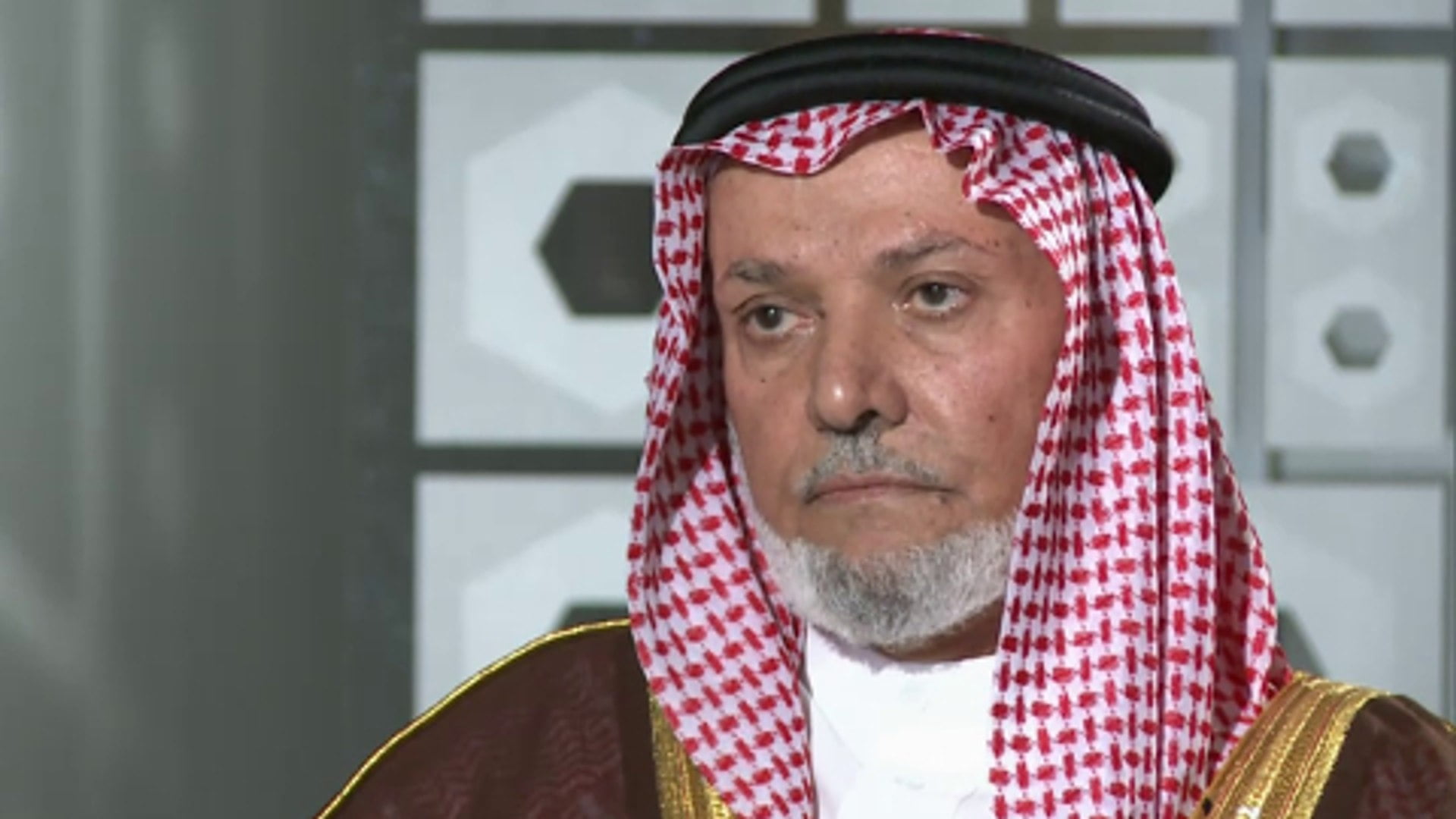
Harith al-Dhari. Credit: Al Jazeera
During this same period (2003-2006), the Ba’athists likewise represented an important social category of the resistance against the new regime.[10] In 2003, Saddam Hussein himself embodied the engagement of the Ba’athists in the guerrilla war and tried in vain to federate all the resistance fighters around him. He made repeated written and oral calls to make himself heard but in the new Iraq, social mapping did not permit any actor to have an audience, an allegiance, or a national belonging. This is why, besides the Ba’athists, no actor considers Saddam Hussein, before or after his capture on 13 December 2003 or even his hanging on 30 December 2006[11], as the benchmark of the resistance. However, this observation does not alter the fact that, through their armed struggle, the Ba’athists were strongly involved in the destabilisation of the American presence in Iraq and the reconstruction of the political system.
The tribes, deprived of their privileges accorded by Saddam Hussein’s Iraq[12], notably after the Persian Gulf War as reward for their unfailing support for the regime against the uprising of the Shia provinces in the South and the Kurdish ones in the North in 1991, formed a third category of actors, which constituted the sociological base of the resistance. Structured around a corpus of tribal values (honour, dignity, allegiance, etc.) and rooted in the history of the country, these heavily armed tribes took their part in the fight against the occupation. It is true that the behaviour of American soldiers that numbered in the thousands on Iraqi soil (which included torture taken to its extreme on Iraqi prisoners[13], humiliation of women, home searches with dogs, willful transgression of codes governing tribal way of life) encouraged and motivated the engagement of tribal society in the resistance.[14]
The Salafi jihadists, who in 2003 were only a small minority, quickly became a hyperactive force for mobilisation against the United States of America in Iraq, but also against the Shia power installed in Baghdad, then a strategic ally of Washington and paradoxically of Tehran. Despite their ethnic diversity (Arabs, Kurds) and despite their organisational diversity (internationalist jihadists and nationalist jihadists), the jihadi salafists imposed themselves little by litttle on the scene as the actor having the monopoly on the representation of the resistance.
Rejection of the formation of the Iraqi Provisional Government, rejection of the legislative elections, rejection of the Constitution, radicalisation of violence in the name of holy war against the new American “crusade” and against the occupation of Iraq by the Shiite apostates and by the Kurdes… During three difficult years, the Sunnis waged a dead end war during which they lost all sense of pragmatism, rationality, political intelligence that for centuries had characterised the identity of the group. In the course of this war, they lost the support of international powers, they lost access to the state’s resources, their territory was totally destroyed, their social base drastically impoverished and their place in Iraq is regularly questioned.[15] It is precisely at this critical moment in their history that an important segment of the Sunnis had woken up and tried to find a way out of this deadlock in which they found themselves in.
The Awakening
“Awakening” is the description employed by the Sunnis themselves to identify their awareness of the “catastrophe” in which they found themselves in. The “awakening”[16] is thus a moment of distancing from a reality that corresponded with, roughly speaking, the collective suicide of the community, reviewing what had not worked, moving to actions that make it possible to recover a part of what had been lost since the occupation of 2003.
On the strength of their social base, their hierarchical organisation and their historicity, the Sunni tribes cut their link with a resistance dominated by the jihadi Salafists of the Abu Musab al-Zarqawi type and established a strategic relationship with the American army. Following several bilateral working sessions, during which questions were discussed on armament, political integration, financing, support and training, the Sunni tribes’ “Council of the Awakening” was born, a force that was both military and political.[17]
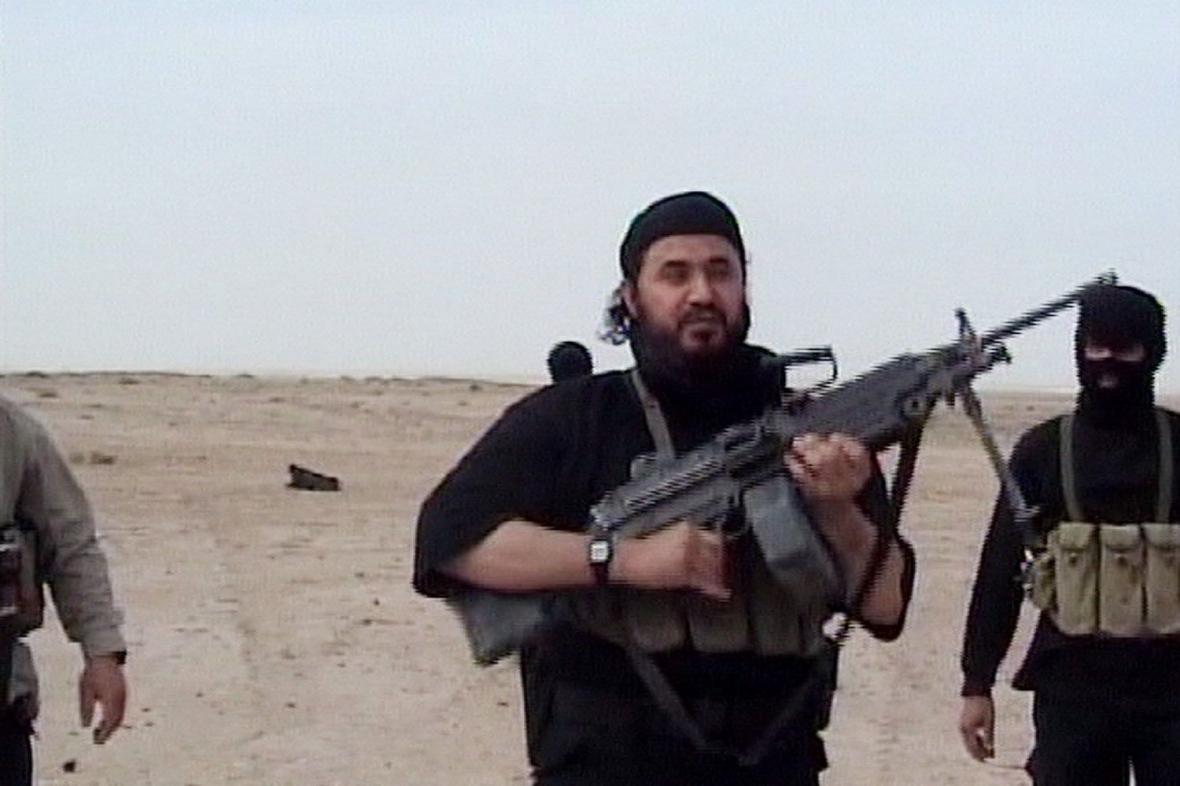
Abu Musab al Zarqawi. Credit: The Times
In effect, the United States of America committed themselves to provide weapons to the Sunni militias of this new tribal organisation, to finance their entire operation, and to act as guarantor of the reintegration of the Sunnis into the Iraqi state.[18] Faced with this American engagement, the Council of the Awakening promised to invest in the war to eradicate jihadists. This Sunni awakening reminds us of that of the Shiites in the 1930’s, when they decided to abandon their resistance to the British and to integrate themselves in the Iraqi state. The difference between the two events is that the British refused the Shiites’ proposition, which had the effect of annihilating the opportunity to construct an Iraqi nation, while the Americans of 2006 had seized this opportunity to form an Iraqi nation, without succeeding to do so.
This was a radical reversal: at the start of 2006, the Sunni land had become a battlefield between the militias of the Awakening and the jihadi organisations. Everything began with Al Anbar Province, where the war had caused thousands of deaths between the two antagonistic camps. However, the confrontation did not limit itself only to Anbar, as the other Sunni provinces had rapidly been invaded and destroyed by the war: scores were beheaded, people were buried en masse, cities and villages were destroyed; the situation gave the impression that anything goes in this dirty war.
In 2010, the militias of the Awakening had accomplished their mission: the jihadi organisations had been considerably weakened; in the Sunni areas, the security situation had improved, the American forces were relatively freed from the nightmare of terrorism. On the other hand, the promise for the integration of the Sunnis into the Iraqi state controlled by the Shiite Nouri al-Maliki was not entirely kept by the United States of America. On the contrary, as soon as the jihadi organisations were gotten rid of, the Iraqi government radicalised its policy of represseion of Sunnis identified as enemies of the new Iraq: bombardment of cities, burning of villages, besieging populations, displacing forcefully Sunnis from Baghdad for them to be replaced by Shiites, putting up of posters of Iranian Shiite ayatollahs in the heart of Sunni cities… All possible methods were used.[19]
So, the Shia government, in refusing to include these heavily armed and experienced men, created the objective conditions for the rise again in power of a Sunni jihadism that would give birth to the organisation known as the Islamic State (Daesh) and put in place the caliphate in 2014. These militias of the Awakening, deceived by the Iraqi government and the United States of America, would integrate themselves into the only offer left on the resistance market, namely the organisation of the Islamic State.
In the course of this same period, the main Sunni figures had been chased from Iraq and some among them had been sentenced to death. The journey of Tariq al-Hashimi is one example. A member of the Muslim Brotherhood, Hashimi joined the political process in 2003 and became vice president of the Iraqi Republic (2006-2012). In December 2011, Prime Minister Nourri al-Maliki named him a top terrorist actor and issued an international arrest warrant for him. Thereby excluded from government and chased by his government, Hashimi, one of the more moderate actors among the Sunnis, spent his time in exile between Qatar and Turkey.[20]
It is in this context that the exclusion, or even the humiliation, incontestably collective, of the Sunnis reached such an alarming level that certain social categories saw the Islamic State as the expression of the collective conscience of Sunnis in Iraq.[21]

Tariq al-Hashimi. Credit: AFP
The Caliphate
Indeed, the factors that shaped the conditions for the birth of the Caliphate in the Sunni territory[22] are principally the American withdrawal from Iraq in 2011 and the “paradoxical positions”[23] that had greatly facilitated the acceleration of the oppression of the Sunnis by the new Shia elite in power, as well as the ultra-violent strategies adopted by the government against the civil Sunni protest movement that took shape in the regional context of the Arab Spring between 2011 and 2014.
In January 2014, the province of Al Anbar, once the cradle of the Council of the Sunni Awakening, opened its door to the jihadists by letting them take control of Fallujah, one of the biggest cities in the province! By this gesture, the Sunnis sent a strong message to the Shiite government of Baghdad. Caught up in its policy of de-sunnification, the government of Nouri al-Maliki did not heed the warning and did not understand the gravity of this event.
On 10 June of the same year, Mosul, the Sunni capital of Iraq, fell into the hand of the jihadists.[24] The Iraq army fled to Iraqi Kurdistan. Nours al-Maliki, then Prime Minister, asked the President of the Kurdistan Regional Government to send the special forces of the Kurdish army (peshmergas) to protect the oil city of Kirkuk in order to prevent its control by the jihadists. On 29 June 2014, the Islamic State restored the Caliphate[25] and designated Ibrahim Awwad Ibrahim Ali al-Badri al-Samarrayi, known under the name Abu Bakr al-Baghdadi, as Caliph of all Muslims.
Born in 1970 in Sammarra to a practicing Sunni family, Ibrahim left his native city at the age of 18 to move to Baghdad and study Islamic sciences at university. He obtained his doctorate in 2000 and, for 14 years, he lived in a small room of the mosque where he was the imam and preacher during Friday prayers. A football amateur, the young Ibrahim created a team with the youth of his mosque and made himself the captain. In 2004, he joined the organisation Tawhid wal-Jihad, created by al-Zarqawi, and became one of its leading members. In February 2004, he was arrested and incarcerated by the American army. In his prison, he took up once again his role as imam and led group prayers and transformed the prison into a school of jihadi education.
Freed in December of the same year, he resumed his jihadi actions under the direction of al-Zarqawi until the death of the latter in 2006. Thereafter, he pursued his engagement in the jihadi group under the direction of Abu Hamza al-Muhajir, Zarqawi’s successor. The same year, al-Muhajir changed the name of his group in order to announce the birth of a new organisation: the Islamic State of Iraq.
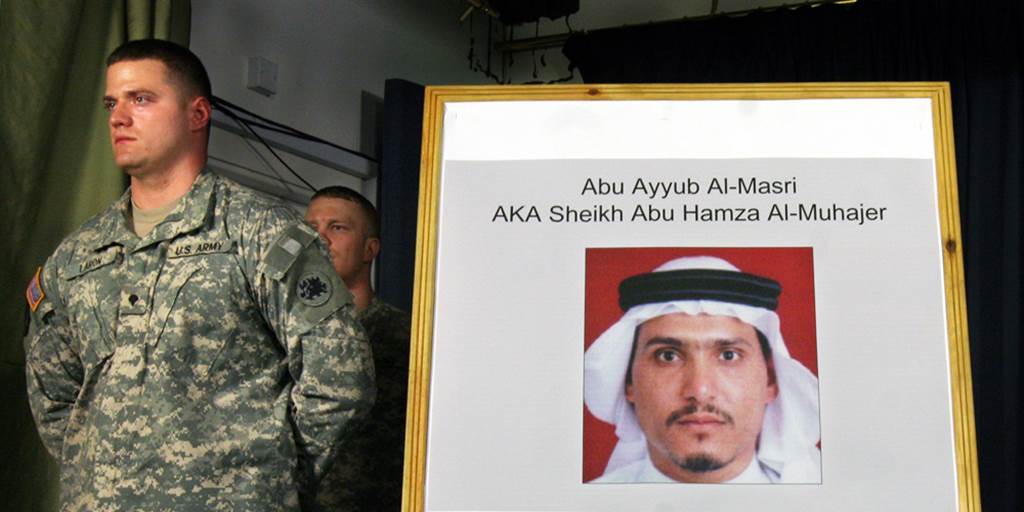
A U.S. soldier stands by a photograph of Abu Ayyub al-Masri. Credit: Karim Kadim / AP
With his strong religious education, al-Baghdadi was assigned responsibility for what was the equivalent to the ministry of justice and of the organisation. He was similarly chosen as a member of the organisation’s Directorate-General. In 2010, al-Muhajir was also assassinated by the American army and his disappearance from the jihadist scene was the opprtunity that facilitated the rise in power of al-Baghdadi, because the same year he was chosen to be the emir by the Directorate-General of the organisation. Thus, he became the leader of the jihadists of al-Qaeda in Iraq.
In 2011, he gave the order to one of his Syrian subordinates, Abu Mohammad al-Julani, to found the Syrian branch of his organisation. Julani, born in 1984, executed the order and announced the birth of the “al-Nusra Front.” Thus, his organisation became “the Islamic State of Iraq and the Levant” (ISIL). However, disagreements on the strategies in the fight appeared prematurely between the two jihadists. Joulani wished to cooperate with all Sunni organisations in the war against the regime of Bashar al-Assad. Al-Baghdadi refused categorically any joint actions with the opponents of the Ba’athist regime and wanted to single-handedly dominate the Syrian-Iraqi scene. The international leader of al-Qaeda asked that al-Baghdadi respected the independence of the Syrian branch. The latter gave a negative response and distanced himself from al-Qaeda. From this act, the two branched brutally separated and several inter-jihadi military confrontations took place.[26] However, on 10 June 2014, with the fall of Mosul, the balance of power changed in al-Baghdadi’s favour, who became the Caliph of Muslims on 29 June 2014. On 27 october 2019, at the age of 48, al-Baghdadi was assassinated in Syria by the American army.
As soon as the Caliphate was installed, the Sunnis understood that they were caught between the rule of a Shia government carrying out systematic exclusion, collective displacement and structural extermination in certain zones and the rule of the jihadists’ Caliphate that turned their country into the world’s biggest slaughterhouse[27]: journalists were beheaded, women were stoned, children turned into human bombs, the opening of slave markets, minorities massacred, issuance of social and cultural bans, declaration of war against the entire world… The Caliphate had become an unimaginable nightmare for the Sunnis.
In addition, between 2014 and 2017, the international coalition led by the United Stated against Daesh’s Caliphate[28] dropped thousands of bombs on the Sunni cities and villages where the jihadists had built their military camps, their frontlines, and the reign of their utopia. Everything that was not destroyed between 2003 and 2014 in the resistance against the occupation or the confessional war that followed had been destroyed by the hypermodern bombs of the international coalition against terrorism. When then-Prime Minister of Iraq Haider al-Abdi announced on 9 December 2017 the victory over the Daesh Caliphate, anti-terrorist special forces entered Mosul only found immense fields of ruins. In January 2018, the World Bank estimated the total cost of the destruction caused by the war against Daesh at $45.7 billion![29] However, by 2021, the reconstruction project will not even have started.
“The Sunni-ness”
Coming out of the Daesh war, following a thorough review of their action strategy and the context in which they found themselves in, a large segment of the Sunni elite have developed a new discourse on the urgency and necessity of constructing a federated entity for Sunnis, similar to that of the Kurdistan Regional Government. Neither Shiites nor Daesh, these elites have the will to find a new alternative that would permit them to enter the new Iraq by another door, namely federalism.[30]
This review of what has happened and the development of an entity around “Sunni-ness” has converged with a serious reflection in decision-making circles in Washington on the change of U.S. policy towards Iraq. Since 2003, the territorial unity of Iraq formed the principle base of American strategies in the country. It is in the name of this principle that, when the Kurds organised an independence referendum for Kurdistan in 2017, Washington, in complete cooperation with Shia militias, punished President Masoud Barzani, who was considered a traditional ally. But it is highly likely that this episode is already behind them, as the Americans themselves have already begun exploring the necessity of the creation of an autonomous entity for the Sunnis.

Masoud Barzani. Credit: AA
The assassination of Qassem Soleimani and Abu Madhi al-Muhandis on 3 January 2020 and the adoption of a resolution by Shiite parliamentarians on 5 January demanding the Iraqi executive to revise the military accord that links it with the United States, in view of the departure of American troops[32], reinforced the unprecedented position of the supporters in the American administration of a Sunni entity. However, this does not mean the supporters of a unified Iraq that is under the control of a pro-American have disappeared. On the contrary, the rise to power in May 2020 of Mustafa al-Kadhimi, a Shiite considered pro-American, is evidence that the ambitious project of a Sunni entity could have adversaries in Washington. For the United States, Iraq is important as it can be used as a fundamental base against the Islamic Republic of Iran; but, if Washington is definitively convinced that the country has become the exclusive domain of Iran, then all options are thinkable, including partition.
Thus, the rejection of Iranian domination in Iraq is the problem on which the Sunnis and the Americans, yesterday’s enemies and today’s allies, can find a strategic accord. In this relationship, there is certainly an international power which has considerable levers and that could impose itself militarily, economically and diplomatically, but there is also a community that is at odds with its Shiite “brothers” who find themselves in an impasse without any prospect of national conciliation or development of a contract, a pact, a federation. In fact, this community, which strongly opposed the occupation of Iraq in 2003 and participated in the resistance to the Americans, now finds itself in active cooperation with the latter, who are considered as the “saviours” in the face of an Islamic Republic of Iran identified as the source of Sunni misfortune.
It is totally erroneous to say that this project for a territorial entity based on “Sunni-ness” is purely American and non-Sunni. The caution and engagement of the United Arab Emirates and Saudi Arabia in the project’s development is further evidence of the complexity of what some would present as purely an American “plan.” In fact, it is unlikely that one can understand what is happening without taking into consideration the local conditions that interact with regional and international conditions.
Can we imagine a Sunni consensus on such a project? Like the Shiites and the Kurdes, the Sunni community is also filled with categories of actors belonging to different ideologies, different social structures and different geopolitical positions, which prevents consensus around a programme, a project, or even a framework. Arab nationalism, Iraqi nationalism, tribalism, Islamism, jihadism, new generation without ideology, pro-Turks, pro-Saudis, and even pro-Iranians… The plurality of Sunnis is a concrete phenomenon reflecting a reality of a group in search of a place that permits it to leave the oppressive situation it has found itself in since 2003. However, the accompaniment of American military and politics, Emirati financing, and the participation of major actors from the Sunni community, such as Mohamed Al-Halboussi, the current Speaker of the Council of Representatives, and his partners could give a strong impetus for the emergence of this Sunni entity, which is already at this stage provoking the rage of pro-Iranian figures in power in Baghdad.[33]
[1] Translation note: original term used was “Sunnicité”, a neologism used by the author to refer to the Sunni community but not necessarily Sunni Islam.
[2] Hassan al-Alawi, Les Chiites et l’État-nation en Irak, 1914-1990, en arabe, Edition Dar as-saqafa li at-tibaa wn-nashr, Qom, Iran, 1990, p. 45.
[3] Abbas al-Azzawi, L’Histoire de l’Irak entre deux occupations, en arabe, Edition Bagdad, 1935, vol. 4, p. 144.
[4] Abdel Nasser al-Mahdawi, « Le génocide des Sunnites arabes », en langue arabe, New Iraq Center, le 25 juillet 2017. http://www.newiraqcenter.com/.
[5] Harith Al Dabbagh, « La débaathification en Irak : justice transitionnelle ou simple vengeance ? », in Revue Québécoise de droit international, volume 27-1, 2014, pp. 31-60 ; https://www.persee.fr/doc/rqdi_0828-9999_2014_num_27_1_1359
[6] Khamis Daham, Le parti islamique irakien, en arabe, Revue al-Adab, publication de l’Université de Bagdad, n° 5, 2013.
[7] Pour plus de détails par an, par mois et même par ville, voir le site du collectif disponible à la fois en arabe et en anglais : https://www.iraqbodycount.org/database/
[8] Peter Harling , « Les dynamiques du conflit irakien », Critique internationale, 2007/1 (no 34), p. 29-43. DOI : 10.3917/crii.034.0029. URL : https://www.cairn-int.info/revue-critique-internationale-2007-1-page-29.htm
[9] « Qui est Harith al-Dhari ? », en arabe, Noon Post, le mars 2015. https://www.noonpost.com/content/5808
[10] « Bass : cinquième année de l’occupation sera l’année de la victoire de la résistance », en arabe, al-Quds al-Arabi, le 23 mars 2007. https://www.alquds.co.uk/
[11] Violaine Roussel, « Chronologie. L’intervention américaine en Irak en quelques dates clés », dans : , Art vs war. Les artistes américains contre la guerre en Irak, sous la direction de Roussel Violaine. Paris, Presses de Sciences Po, « Académique », 2011, p. 10-12. URL : https://www.cairn-int.info/art-vs-war–9782724611946-page-10.htm
[12] Baram Amatzia, « Irak, le registre tribal », Outre-Terre, 2006/1 (no 14), p. 159-168. DOI : 10.3917/oute.014.0159. URL : https://www.cairn-int.info/revue-outre-terre1-2006-1-page-159.htm
[13] Abigail Solomon-Godeau, « Torture à Abou Ghraib : les médias et leur dehors », Multitudes, 2007/1 (no 28), p. 211-223. DOI : 10.3917/mult.028.0211. URL : https://www.cairn-int.info/revue-multitudes-2007-1-page-211.htm
[14] Mathieu Guidère, « L’Irak ou la terre promise des jihadistes », Critique internationale, 2007/1 (no 34), p. 45-60. DOI : 10.3917/crii.034.0045. URL : https://www.cairn-int.info/revue-critique-internationale-2007-1-page-45.htm
[15] Harith Hasan al-Qarawee, « Iraq’s Sectarian Crisis – A Legacy of Exclusion », Carnegie, le 23 avril 2014. https://carnegie-mec.org/2014/04/23/iraq-s-sectarian-crisis-legacy-of-exclusion-pub-55372
[16] Richard A. Oppel, « Iraq Takes Aim at U.S. – Tied Sunni Groups’ Leaders », The New York Times, le 21 août 2008 : https://www.nytimes.com/2008/08/22/world/middleeast/22sunni.html?_r=1&hp=&oref=slogin&pagewanted=print
[17] Michal Harari, « Uncertain Future for the Sons of Iraq », Institute for the Study of War, le 3 août 2008 : http://www.understandingwar.org/sites/default/files/Backgrounder_SonsofIraq_0.pdf
[18] Ibrahim Wali, « Communiqué de la Marjaia chiite au Roi Ghazi », en arabe, Azzaman, Bagdad, le 15 juin 2019.
[19] Adel Bakawan, L’impossible Etat irakien, Éditions l’Harmattan, 2019, p. 110.
[20] « Iraq VP Tariq al-Hashemi sentenced to death », BBC, le 9 septembre 2012.
[21] Voir Pierre-Jean Luizard, Le piège Daech, op. cit., surtout le chapitre sur « L’irruption de l’État islamique ».
[22] Taillat Stéphane, « « L’impuissance de la puissance » ? : Une approche sociologique de la contre-insurrection américaine en Irak », Politique américaine, 2012/1 (N° 19), p. 27-48. DOI : 10.3917/polam.019.0027. URL : https://www.cairn-int.info/revue-politique-americaine-2012-1-page-27.htm
[23] « Éditorial », Politique étrangère, 2020/1 (Printemps), p. 5-8. DOI : 10.3917/pe.201.0005. URL : https://www.cairn-int.info/revue-politique-etrangere-2020-1-page-5.htm
[24] Roussel Cyril, « Nettoyage ethnique, déplacements de population et repeuplement dans le gouvernorat de Ninive (Mossoul, Nord-Irak) », Outre-Terre, 2015/3 (n° 44), p. 250-262. DOI : 10.3917/oute1.044.0250. URL : https://www.cairn-int.info/revue-outre-terre2-2015-3-page-250.htm
[25] Benkheira Mohammed Hocine donne une explication pertinente des concepts de « Califat » chez les Sunnites et « Imamat » chez les Chiites. Le terme Khâlifa (« calife » en français) désigne celui qui prend la place d’un autre, un successeur, en un sens non nécessairement institutionnel ou politique, Imâm met l’accent sur la fonction de direction. Mohammed Hocine Benkheira, « Califat et Imâmat », in Mohammad Alidir Ami-Moezz., Dictionnaire du Coran, Robert Laffont, 2007, p. 145.
[26] Al-HAHMI Hosham, L’Univers de Daech : de sa genèse à l’annonce du Califat, en langue arabe, Londres, éditions Dar al-Hikma, 2015.
[27] Hélène Sallon, L’État islamique de Mossoul. Histoire d’une entreprise totalitaire, Éditions La Découverte, Paris, 2018.
[28] Mongin Olivier, « « Qui est l’ennemi ? » », Esprit, 2016/1 (Janvier), p. 18-21. DOI : 10.3917/espri.1601.0018. URL : https://www.cairn-int.info/revue-esprit-2016-1-page-18.htm
[29] Banque mondiale, Iraq : Reconstruction & Investment. Part 2 : Damage and Needs Assessment of Affected Governorates, janvier 2018.
[30] Suadad al-Salhy, « Les États-Unis cherchent à créer un État sunnite pour contrer le déclin de leur influence », Middle East Eye, le 24 janvier 2020. https://www.middleeasteye.net/fr/reportages/irak-les-etats-unis-cherchent-creer-un-etat-sunnite-pour-contrer-le-declin-de-leur
[31] Bakawan Adel, « Le Kurdistan irakien : un État dans l’État ! », Maghreb – Machrek, 2019/3 (n°241), p. 5-15. DOI : 10.3917/machr.241.0005. URL : https://www.cairn-int.info/revue-maghreb-machrek-2019-3-page-5.htm
[32] Pierre Cochez, « Le Parlement irakien demande l’expulsion des troupes étrangères », La Croix, le 5 janvier 2020.
[33] Abdoul Kader al-Janabi, « L’idée d’une entité sunnite revient en Irak », Raseef, le 17 juin 2020. https://raseef22.net/


